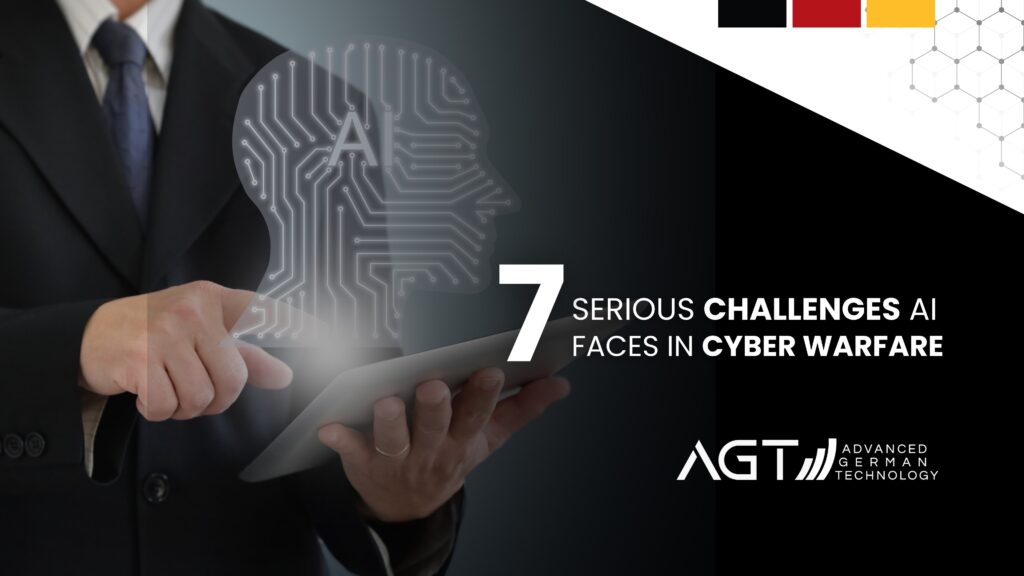
7 Serious Challenges AI Faces in Cyber Warfare
These days, wars aren’t just happening on the ground, they’ve moved online, into a space you can’t see. And now, artificial intelligence (AI) is right in the middle of it. It’s not just helping behind the scenes; it’s actually taking part in both attacks and defenses.
AI systems can now analyze, decide, and act sometimes faster than any human. But here’s the real concern: what happens when AI makes the wrong call at a critical moment? Or worse, what if it becomes a vulnerability that attackers can use against us?
Let’s take a closer look at 7 Serious Challenges AI Faces in Cyber Warfare, and how each one could turn smart systems into serious threats.
1-The “Black Box” Problem: When We Don’t Know Why AI Made That Decision
Many AI systems work like a black box. You feed in the data, and they give you a result, but no one really knows how they got there. That lack of clarity makes it hard to respond quickly during a crisis or figure out what went wrong after the fact. In a war-like cyberattack, that uncertainty is a huge problem.
2-Adversarial Attacks: Tricking the Machine, in a Language It Understands
Hackers are finding clever ways to fool AI systems. They can tweak an image or data point in a way that humans wouldn’t even notice, but it’s enough to throw off the AI. Imagine a threat detection system missing a real attack just because someone made a tiny, intentional change to the data it’s analyzing.
3-The Talent Gap
Technology is moving fast, but the number of skilled people who really understand how to work with AI in cybersecurity is still low. This shortage leads to configuration errors, misinterpretations of AI results, and systems that aren’t being used to their full potential, which opens the door to mistakes and threats.
4-Cost and Resources: High Investment, Uncertain Return
Building and maintaining AI systems that actually work in cybersecurity isn’t cheap. You need infrastructure, high-quality data, and the right people. For organizations with tight budgets, it can be tough to make these investments without cutting corners somewhere else, sometimes in areas that really matter.
5-Too Much Trust in Automation: When Algorithms Call the Shots
In some organizations, there’s a tendency to lean too heavily on automation when it comes to spotting and responding to threats. That might sound efficient, but it can also lead to mistakes, like shutting down a safe system or missing a real threat that doesn’t match the AI’s patterns exactly.

6-When Hackers Use AI Too
Attackers aren’t sitting back while AI improves, many of them are using it too. From malware that learns and adapts, to phishing attacks so convincing even advanced systems fall for them. Deepfake technology is also being used to create fake videos or impersonate people, which can be especially dangerous in sensitive environments.
7-No Clear Rules or Ethics Yet
Right now, there are no widely accepted international laws or ethical guidelines for how AI should (or shouldn’t) be used in cyber warfare. This lack of structure means hostile groups can use AI however they want, with no real consequences. That’s a serious concern when it comes to national security and digital privacy.
So, What Can We Do? It Starts With Building Smarter, More Responsible AI
We need to rethink how we design and use AI in cybersecurity. It’s not just about building powerful tools. They also need to be understandable, safe, and harder to exploit.
At AGT Technology, we don’t just deliver AI solutions and walk away. We provide:
- Build systems that are better protected against smart attacks
- Train teams to understand and interpret AI decisions with confidence
- Create custom-built tools that fit each client’s needs—especially in sensitive or high-risk sectors
- Offer technical advice to help clients use AI in a secure, thoughtful way
If you’re looking to help your team use AI in a safe, professional environment, you can reach out to us here:
Article references:
- World Economic Forum – The risks of AI in cyberwarfare
https://www.weforum.org/agenda/2022/04/ai-in-cyberwarfare-risks/ - Brookings Institution – AI and the future of warfare
https://www.brookings.edu/articles/ai-and-the-future-of-warfare/ - NATO Review – How AI is changing the nature of war
https://www.nato.int/docu/review/articles/2020/06/08/how-artificial-intelligence-is-changing-the-nature-of-war/index.html - MIT Technology Review – The AI “black box” problem
https://www.technologyreview.com/2018/11/11/103781/ai-black-box-problem/ - IBM Research Blog – What is adversarial AI?
https://www.ibm.com/blogs/research/2020/02/adversarial-ai/ - CSIS (Center for Strategic & International Studies) – The ethics and legal implications of AI in armed conflict
https://www.csis.org/analysis/artificial-intelligence-ethics-and-legal-implications-armed-conflict - Forbes – The cybersecurity talent gap meets AI
https://www.forbes.com/sites/forbestechcouncil/2023/04/12/the-cybersecurity-talent-gap-meets-ai/?sh=7fcd0b1c1dbe

